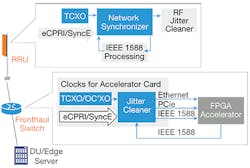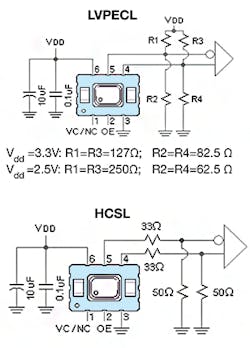Synchronizing the 5G Network with TCXOs
What you’ll learn:
- Why stable clocking in network synchronization is critical to making 5G a reality.
- Why TCXOs are needed.
5G mobile technology is poised to profoundly change the way the world communicates, dramatically improving everything from massive Internet of Things (IoT) networks, AI, and virtual reality, to security, robotics, and cloud computing, to name just a few applications.
These 5G networks will connect machines and devices at higher data speeds than their 4G network predecessors and combine that with ultra-low latency. But to maintain consistent operation and high reliability, network components must be synchronized.
Accurate timing (clocking) plays a crucial role in maintaining synchronization within a mobile network. Inaccurate synchronization and timing can lead to interference between nodes in a radio access network (RAN), which is the part of a wireless system that connects individual devices such as smartphones and smart devices to other parts of a network through a radio link. Error-prone oscillators and clocks can cause time shifts that degrade network performance and reliability.
That’s why stable clocking in network synchronization is critical to making the transformative potential of 5G a reality. Temperature-compensated crystal oscillators (TCXOs), which are designed to operate in high-temperature environments, hold the key.
Oscillators are electronic circuits that use a crystal to generate a periodic electrical signal with constant frequency, also known as a clock or timing signal. Most digital circuits rely on clock signals to synchronize the different components within them.
Clocking and Synchronization in 5G Applications
A RAN optimizes service performance and reliability of 5G applications. It consists of different synchronized components, each contributing unique functionality that collectively delivers required services. Timing accuracy and availability, as well as cost, are important considerations for the end product.
An open RAN architecture typically consists of a remote radio unit (RRU), fronthaul switch, and a distributed unit (DU), with a TCXO or OCXO (oven-controlled crystal oscillator) generating the clock signal to synchronize these devices. These components need to be precisely synchronized to avoid data packet loss and system interruptions.
Many 5G networks rely on time-division duplexing (TDD), a duplex communications method where inbound signals are separated from outbound signals based on time allocation in the same frequency band. TDD requires all devices to be precisely synchronized.
The synchronization frequency is typically based on the IEEE 1588 Precision Timing Protocol (PTP), though Synchronous Ethernet (SyncE) is another standard that’s occasionally used. The network architecture dictates whether PTP, SyncE, or both are employed for synchronization.
In PTP, a grandmaster device uses a sync source (usually GPS-based) to create several timestamped PTP packets that are delivered to follower clocks at other locations. The packets calculate the time offset between the grandmaster and follower clock, after which a local clock signal is generated by the follower clock at its own location. PTP is an intelligent system and can adapt to grandmaster loss.
SyncE is an older system in which a high-quality clock reference (usually from a GPS or cesium clock source) is used to time the output from the core of the network. At other locations on the network, clock recovery takes place, analyzing the signal edges of the output signal and utilizing them to derive their own clock signal for the receiving equipment.
The DU must pass a precisely synchronized timing signal to the fronthaul switch and a RRU. DU clocking must be heat resistant under a heavy load; otherwise, it will require adding a fan to the system. And the RRU must be environmentally robust since it’s usually placed outdoors on rooftops and poles, and near roads and highways.
Oscillator Challenges in 5G Applications
Environmental stress can influence oscillator performance. 5G networks rely on a large density of radios, which are often mounted in locations vulnerable to vibration from sources, such as trucks, trains, cars, wind, and thunder. These devices also experience significant swings in temperature. Consequently, oscillators deployed in these radios must maintain stable performance during environmental stress to prevent dropped links.
Cost and availability—as well as size, heat, and power—are important considerations for engineers, too. TCXO and microelectromechanical-system-based (MEMS) oscillators are replacing other types due to their performance and affordability.
However, low-cost MEMS oscillators can introduce additional constraints. They may not react well to physical-layer rearrangement, and typically don’t support the necessary bandwidth for PTP G.8275.2, limiting them to the lower bandwidth used in the G.8275.1 PTP profile.
Why TCXOs are Needed
The temperature resistance of TCXOs can compensate for the frequency-temperature characteristics inherent to the crystal unit. A voltage-controlled crystal oscillator (VCXO) is an important TCXO component that links to a temperature-sensing circuit and applies minute correction voltages to the oscillator. TCXOs provide stabilities of 1 part per million (ppm) to 0.1 ppm.
High stability while consuming minimum power are other notable advantages of TCXOs. These features make them ideal for numerous 5G communications and telecom applications, such as point-to-point RF, GPS, mobile phones, and other precision RF connectivity systems.
5G infrastructure equipment also is becoming physically smaller. As a result, it can be installed in locations that are space-constrained and often remote with limited connectivity to power sources, requiring equipment to maintain low power consumption. TCXOs provide the necessary performance in a small package with low power consumption. Since TCXOs are temperature-compensated, they’re able to adapt to and maintain their stability through temperature changes.
Final Thoughts
For 5G applications to achieve their full potential, they will need effective network synchronization for stable and reliable network performance. Various compelling use cases for 5G, such as IoT and industrial automation, require precise timing, and the need for accurate synchronization will continue to grow.
TCXO oscillators can provide stable clocks at high frequencies in a small footprint, making them well-suited candidates to handle clocking duties for 5G applications.
About the Author

Randall Scasny
Senior Community Content Specialist, Newark
Randall Scasny is a senior community content specialist for Avnet's element14 Community, an electronics industry community of thousands of engineers, industry experts, independent sources, makers, and STEM advocates from all over the world. For more information about the element14 community, visit https://community.element14.com.




